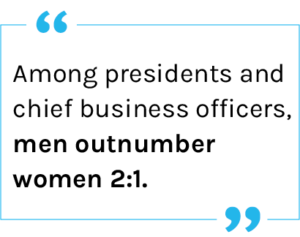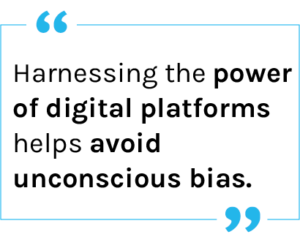What Higher Education Institutions Can Do About Gender Bias
Gender plays a complicated role in hiring and promotion. Its impact is still being understood, but the truth is clear: women are underrepresented in both top administrative positions and among tenure-track and senior faculty in colleges and universities. Women are facing barriers in their higher education career development, and recognizing this fact is vital for institutions that hope to address the disparity in their faculty. How can higher education institutions address inequity and gender bias?
The Complex Role of Gender in Hiring
Despite the strong push to hire more female faculty members, representation of women in some disciplines, including technology, science, mathematics, and engineering, is still low. This lack of representation compounds on itself: faculty mentor students, and female students seeking female role models often don’t find them. All departments, including STEM, need to work actively to create an inclusive culture that seeks out and champions women.
The first step is to examine the metrics of your applicant pool and your hiring statistics. PeopleAdmin’s analytic tools can give insight into diversity hiring metrics by department, position, salary, and more. See at a macro and micro level how your D&I efforts are making a difference and where you need to push further.
The Persistent Gender Gap
While the gender gap is narrowing in some fields, inequality is still persistent. A study by Women’s Power Gap found that men still hold the bulk of high-paying administrative higher-ed jobs. The problem is even more evident among women of color, who account for just 2.5% of the top earners in higher ed institutions.
Some faculties and disciplines, such as athletics, information technology, and facilities, are consistently male-dominated. The same is true in top-level academic positions; among presidents and chief business officers, men outnumber women 2:1.
top-level academic positions; among presidents and chief business officers, men outnumber women 2:1.
In addition, family responsibilities tend to impact women’s careers more than men’s. The COVID-19 pandemic aggravated this situation, with mothers more likely than fathers to have left the workforce, reduced their working hours, or be interrupted during working hours. In HigherEd specifically, female faculty members with children reported struggling to manage their time and perform the research they expected or planned to undertake. A year with reduced research opportunities could have long-term impacts on promotion and tenure review for many female faculty members.
How HigherEd Institutions Are Fixing the Gap
Diversity and inclusion should be at the core of your institution’s mission. Gender equity may seem like a huge undertaking, given the complex landscape, but there are notable universities that are making significant progress in narrowing the gender gap.
Today, institutions have come up with programs for making hiring and promotion more equitable. For example, the Chalmers University of Technology in Sweden launched a program called Gender Initiative for Excellence (GENIE) to address gender inequality in faculties. The program aims to eliminate cultural and structural barriers that hamper women’s representation.
Others are leveraging anonymity in their hiring and selection process to ensure a fair review of all applicants. The use of blind resumes when reviewing job applicants is one creative approach: the resume has no identifying information, such as sex, age, or ethnicity, preventing applicants from being judged on such details.
As we emerge from a challenging year, it is important for colleges and universities to take into account the uneven impact of COVID-19 on women in the workplace. Institutions should listen closely to their employees as they consider measures to mitigate the gender disparities that were brought to light by the pandemic.
 Harnessing the power of digital platforms and artificial intelligence in hiring and promotion also helps avoid unconscious bias. The right digital platform will allow you to track essential Equal Employment Opportunity (EEO) metrics to give you better visibility of employees’ performance and qualifications for informed hiring and promotion decisions.
Harnessing the power of digital platforms and artificial intelligence in hiring and promotion also helps avoid unconscious bias. The right digital platform will allow you to track essential Equal Employment Opportunity (EEO) metrics to give you better visibility of employees’ performance and qualifications for informed hiring and promotion decisions.
These solutions are not simple, but neither is the challenge they are addressing. Though it may seem daunting and complex, working to address the gender gap at your institution is a vital and worthwhile undertaking.